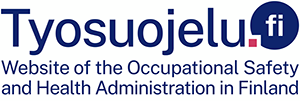High heat in the summer is an issue at many workplaces
Working in high temperatures can reduce job satisfaction and increase the risk of accidents. It usually takes about a week for the body to adapt to heat, so the first hot days are the most challenging for people.
Employers must limit employees’ exposure to high heat even if a workplace has not set an upper limit for acceptable temperatures. Employers have to make sure that the temperature, humidity, airflow and radiating surfaces in working environments do not pose a risk to the health and safety of workers. According to the Occupational Safety and Health Act, employers must minimise the harm caused by heat and cold. Work at temperatures above 28 degrees Celsius is considered to be hot work. Employers must strive to keep temperatures below 28°C by technical means, for example by insulating heat sources or making ventilation more efficient.
If the temperature exceeds 28°C, the length of working cycles has to be limited. Workers can perform light or medium work for 50 minutes per hour at 28–33°C and for 45 minutes per hour in temperatures exceeding 33°C. Employees must be allowed to take breaks in a cooler environment.
For heavy work or very high temperatures, it is necessary to take special protective measures, such as using protective equipment and taking frequent breaks. The primary way for reducing thermal load is technical solutions, such as insulating heat sources and improving ventilation.
For protection against heat:
- If the temperature conditions at your workplace do not comply with recommendations, notify your employer and the occupational safety and health representative. If the employer is unable to reduce the thermal load by technical means, breaks have to be taken regularly.
- You can personally reduce heat stress by wearing light and loose clothing that is appropriate for your work and by drinking enough fluid several times an hour. In physical work, the recommendation is to drink 1–2 dl of water or diluted juice 3 to 4 times every hour. Insufficient hydration may result in dehydration or, in the worst-case scenario, heatstroke. Breaks should be taken in a cool or shaded place if possible.
Keywords
Contacts
Occupational safety and health authorities’ national telephone service +358 295 016 620
Links
Occupational safety and health—healthy work!
As an occupational safety and health authority, we make sure that working in Finland is healthy, safe and fair. We supervise how work is done at workplaces. We also provide guidance and advice and encourage workplaces to do preventive occupational safety and health work out of their own initiative.

Subscribe to releases from Aluehallintovirasto/Regionförvaltningsverket
Subscribe to all the latest releases from Aluehallintovirasto/Regionförvaltningsverket by registering your e-mail address below. You can unsubscribe at any time.
Latest releases from Aluehallintovirasto/Regionförvaltningsverket
Lainsäädäntö uudistui 21.12.2025: Miten asbestityöt pitää tehdä uudistuksen jälkeen?22.12.2025 07:41:37 EET | Tiedote
Asbestilainsäädäntö uudistui 21. joulukuuta. Uudistuneeseen lainsäädäntöön liittyen työsuojeluviranomainen on julkaissut päivitetyn soveltamisohjeen. Soveltamisohje kertoo, miten asbestityöt pitää käytännössä tehdä Suomessa uudistuksen jälkeen.
Hallinto-oikeus: Työsuojeluviranomaisen puolalaiselle yritykselle määräämä laiminlyöntimaksu oli aiheellinen19.12.2025 15:52:23 EET | Tiedote
Lounais-Suomen aluehallintoviraston työsuojelun vastuualue määräsi elokuussa 2024 puolalaiselle yritykselle 5 500 euron laiminlyöntimaksun, koska yritys oli laiminlyönyt velvollisuutensa toimittaa työsuojeluviranomaiselle tietoja työntekijöiden lähettämisestä Suomeen. Yritys valitti laiminlyöntimaksusta hallinto-oikeuteen, joka katsoi, että työsuojeluviranomainen oli voinut pitää yrityksen laiminlyöntejä vakavina ja ratkaisi asian niin, että määrätty laiminlyöntimaksu jäi voimaan. Turun hallinto-oikeus antoi päätöksensä asiassa 19.12.2025.
Regionförvaltningsverket i Västra och Inre Finlands regionala beredskapskommitté sammanträdde för sista gången19.12.2025 13:30:00 EET | Pressmeddelande
Regionförvaltningsverket i Västra och Inre Finlands regionala beredskapskommitté sammanträdde för sista gången den 18 december 2025. De nuvarande beredskapskommittéernas verksamhetsperiod upphör då regionförvaltningsverkens verksamhet upphör den 31 december 2025. Det nya riksomfattande Tillstånds- och tillsynsverket inleder verksamheten den 1 januari 2026. Till myndighetens uppgifter hör bland annat att organisera det regionala beredskapssamarbetet.
Länsi- ja Sisä-Suomen aluehallintoviraston alueellinen valmiustoimikunta kokoontui viimeisen kerran19.12.2025 13:30:00 EET | Tiedote
Länsi- ja Sisä-Suomen aluehallintoviraston alueellinen valmiustoimikunta kokoontui viimeisen kerran 18.12.2025. Nykyisten valmiustoimikuntien toimikausi päättyy aluehallintovirastojen toiminnan päättyessä 31.12.2025. Uusi valtakunnallinen Lupa- ja valvontavirasto aloittaa toimintansa 1.1.2026. Viraston tehtävänä on muun muassa varautumisen alueellisen yhteistyön järjestäminen.
Tillsyn avslöjade brister i behörighetsvillkoren för personalen på privata daghem19.12.2025 11:45:39 EET | Pressmeddelande
År 2025 övervakade regionförvaltningsverken att behörighetsvillkoren enligt lagen om småbarnspedagogik uppfylldes för de privata daghemmens fostrings-, undervisnings- och vårdpersonal samt daghemsföreståndare. Som ett resultat av tillsynen gav regionförvaltningsverken över 200 tjänsteproducenter administrativ styrning.